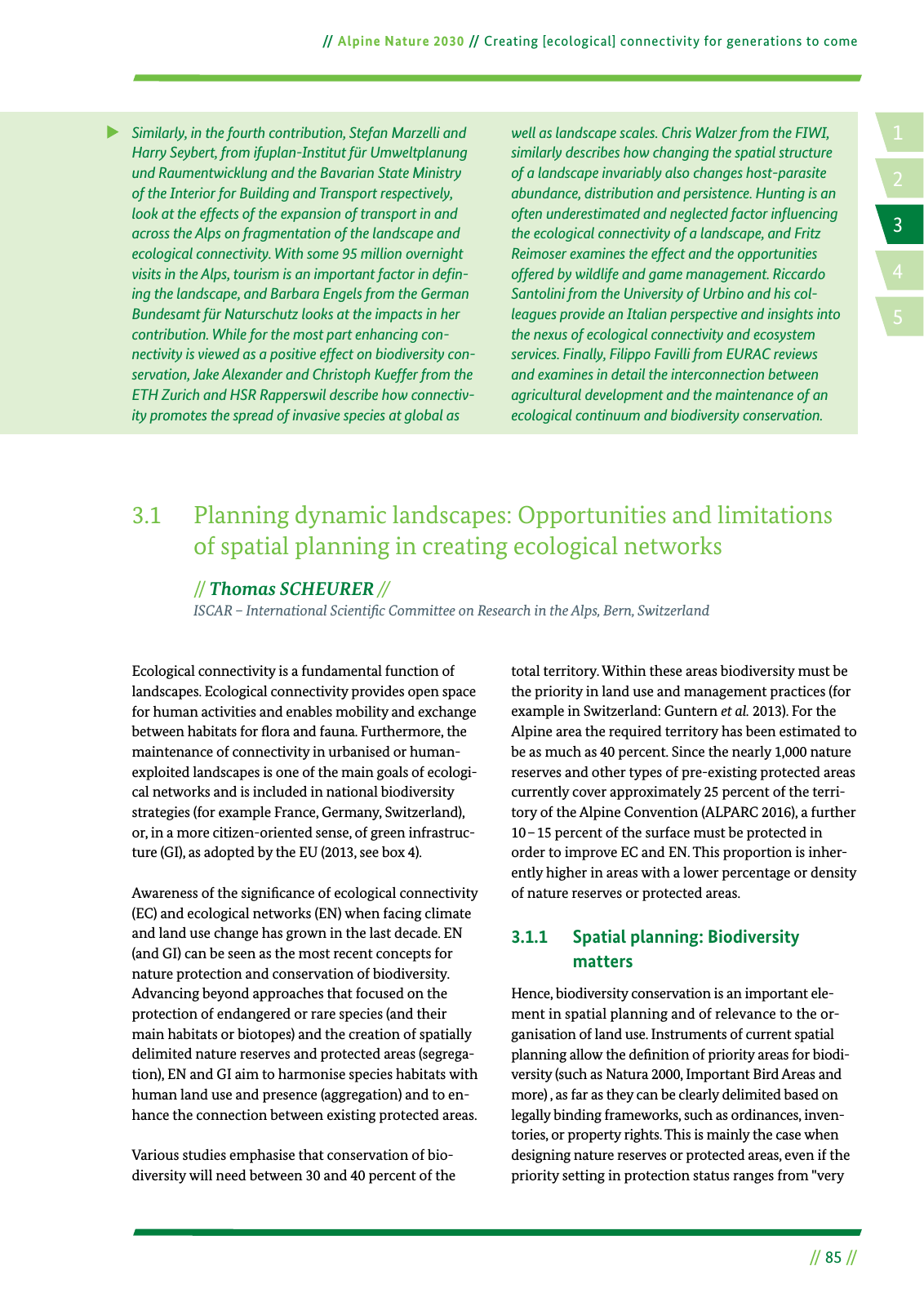14 2 5 3 Alpine Nature 2030 Creating ecological connectivity for generations to come 85 Similarly in the fourth contribution Stefan Marzelli and Harry Seybert from ifuplan Institut für Umweltplanung und Raumentwicklung and the Bavarian State Ministry of the Interior for Building and Transport respectively look at the effects of the expansion of transport in and across the Alps on fragmentation of the landscape and ecological connectivity With some 95 million overnight visits in the Alps tourism is an important factor in de n ing the landscape and Barbara Engels from the German Bundesamt für Naturschutz looks at the impacts in her contribution While for the most part enhancing con nectivity is viewed as a positive effect on biodiversity con servation Jake Alexander and Christoph Kueffer from the ETH Zurich and HSR Rapperswil describe how connectiv ity promotes the spread of invasive species at global as well as landscape scales Chris Walzer from the FIWI similarly describes how changing the spatial structure of a landscape invariably also changes host parasite abundance distribution and persistence Hunting is an often underestimated and neglected factor in uencing the ecological connectivity of a landscape and Fritz Reimoser examines the effect and the opportunities offered by wildlife and game management Riccardo Santolini from the University of Urbino and his col leagues provide an Italian perspective and insights into the nexus of ecological connectivity and ecosystem services Finally Filippo Favilli from EURAC reviews and examines in detail the interconnection between agricultural development and the maintenance of an ecological continuum and biodiversity conservation 3 1 Planning dynamic landscapes Opportunities and limitations of spatial planning in creating ecological networks Thomas SCHEURER ISCAR International Scienti c Committee on Research in the Alps Bern Switzerland Ecological connectivity is a fundamental function of landscapes Ecological connectivity provides open space for human activities and enables mobility and exchange between habitats for ora and fauna Furthermore the maintenance of connectivity in urbanised or human exploited landscapes is one of the main goals of ecologi cal networks and is included in national biodiversity strategies for example France Germany Switzerland or in a more citizen oriented sense of green infrastruc ture GI as adopted by the EU 2013 see box 4 Awareness of the signi cance of ecological connectivity EC and ecological networks EN when facing climate and land use change has grown in the last decade EN and GI can be seen as the most recent concepts for nature protection and conservation of biodiversity Advancing beyond approaches that focused on the protection of endangered or rare species and their main habitats or biotopes and the creation of spatially delimited nature reserves and protected areas segrega tion EN and GI aim to harmonise species habitats with human land use and presence aggregation and to en hance the connection between existing protected areas Various studies emphasise that conservation of bio diversity will need between 30 and 40 percent of the total territory Within these areas biodiversity must be the priority in land use and management practices for example in Switzerland Guntern et al 2013 For the Alpine area the required territory has been estimated to be as much as 40 percent Since the nearly 1 000 nature reserves and other types of pre existing protected areas currently cover approximately 25 percent of the terri tory of the Alpine Convention ALPARC 2016 a further 10 15 percent of the surface must be protected in order to improve EC and EN This proportion is inher ently higher in areas with a lower percentage or density of nature reserves or protected areas 3 1 1 Spatial planning Biodiversity matters Hence biodiversity conservation is an important ele ment in spatial planning and of relevance to the or ganisation of land use Instruments of current spatial planning allow the de nition of priority areas for biodi versity such as Natura 2000 Important Bird Areas and more as far as they can be clearly delimited based on legally binding frameworks such as ordinances inven tories or property rights This is mainly the case when designing nature reserves or protected areas even if the priority setting in protection status ranges from very

Hinweis: Dies ist eine maschinenlesbare No-Flash Ansicht.
Klicken Sie hier um zur Online-Version zu gelangen.
Klicken Sie hier um zur Online-Version zu gelangen.